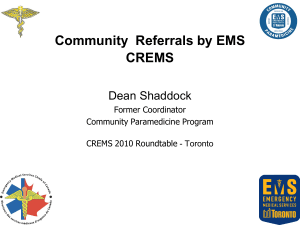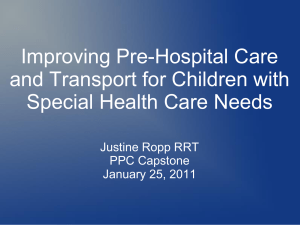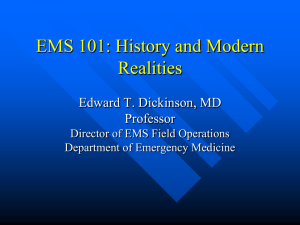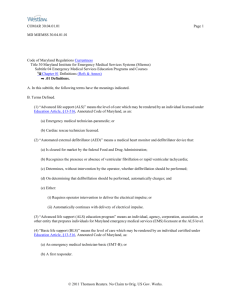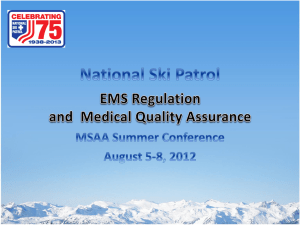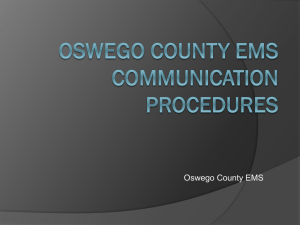Overview of Maryland Emergency Medical Services (P
advertisement
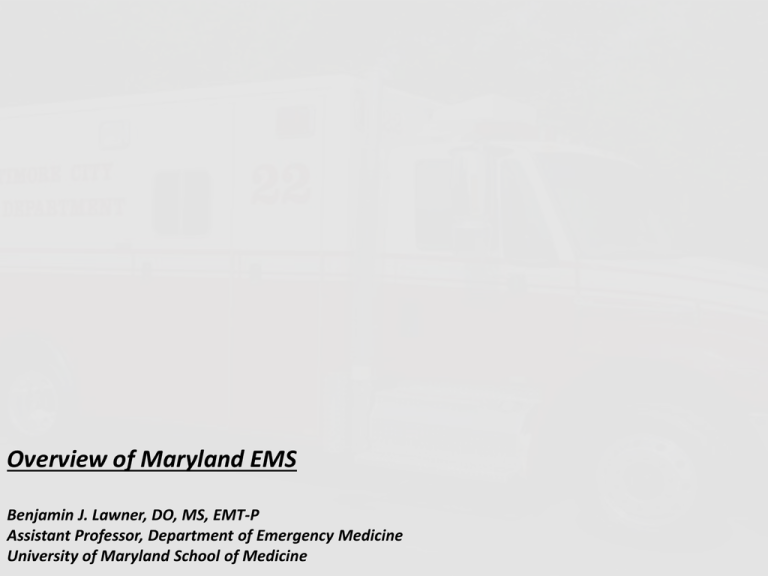
Overview of Maryland EMS Benjamin J. Lawner, DO, MS, EMT-P Assistant Professor, Department of Emergency Medicine University of Maryland School of Medicine Objectives • • • • Understand different types of EMS providers Review training required for each EMS certification level Discuss organization of EMS at the state level Recognize your EMS faculty physicians and their roles in prehospital and disaster medicine Dr. Wade Gaasch •Medical Director, Baltimore City Fire Department •Medical Director, University of Maryland ExpressCare •Medical Director, Baltimore City Police Department Tactical Team Dr. Ben Lawner •Deputy Medical Director, Baltimore City Fire Department •Medical Director, University of Maryland Baltimore County Critical Care Transport Course •Medical Director, CCBC Emergency Medical Technology Program Dr. JV Nable •Attending Physician at MedStar Georgetown University Hospital •Medical Specialist, Maryland Task Force 1 Urban Search and Rescue Team Dr. Debra Lee •Co-Director, UMMC/MIEMSS/UMBC emergency medical services fellowship •Medical Director, Mercy Medical Center Base Station Dr. Douglas Floccare •Medical Director, Maryland State Police Aviation Command Dr. Roger Stone •Medical Director, Montgomery County Department of Fire Rescue Services EMS Provider Types Emergency Medical Technician Emergency Medical Technician • • • • • • 160-300 hours Non invasive skills Patient assisted medication Patient assessment / advanced first aid Minimum qualifications for ambulance crew Courses offered at Johns Hopkins University undergraduate campus, local community colleges, and at fire departments Emergency Medical Technician • Delivers “BLS” or basic life support • Additional skills available depending upon jurisdiction and population based needs • In Western Maryland, EMT’s can obtain and transmit 12 lead ECGs The Advanced/Intermediate EMT Advanced/Intermediate EMT • “Paramedic” level skills • 600-1000 hours • Internship/fire academy training • Minimum level of ALS • Majority of BCFD apparatus staffing “Advanced Emergency Medical Technicians” Advanced EMT Skills • • • • IV access ECG interpretation Medication administration Supraglottic airway placement The Nationally Registered Paramedic Nationally Registered Paramedic • • • • Highest level of ALS training 1200-2000 hours Supervised field internship Advanced assessment/skills Nationally Registered Paramedic • • • • • Must graduate from accredited program Typically 3 semesters + EMT Training leads to certificate or degree Link in the health care system Able to formulate focused field diagnoses Specialty Care Providers Specialty Care Providers Critical / Specialty Care Paramedics • • • • • • Participate in interfacility transfers Additional training in medication infusions Enhanced scope of practice May work with RN, RT, physicians Ventilator management In Maryland, “specialty care transport” considerations apply to patients with advanced in-transport medical needs Critical/Specialty Care Paramedics • • • • • No uniform standard of training Typically regulated by state or jurisdiction National organizations suggest minimum standards Voluntary certification Critical care transport providers Maryland State Police: Aviation Command • State funded • Provides scene response and medical transport for ill and injured • 7 geographically located helicopter bases • Staffed with police paramedics • Twin engine AW139 and Dauphin helicopters • Majority of missions are trauma response Aviation Command •Centralized dispatch system •Expedited transport to definitive care •Also performs select law enforcement and rescue missions •No transport fee charged to Maryland citizens •Established protocols for requesting medevac assistance EMS Oversight in Maryland • Regionalized care • Oversight • Quality assurance • Independent agency • • • • • • State divided into 5 regions Regional councils and medical directors State EMS board comprised of stakeholders Articulation of policy and protocols EMS regulations Administration of medevac operations (MSP) Baltimore City is in MIEMSS Region III EMS Physicians • • • • • • • • Subspecialty training 9 months minimum Field operations Tactical medicine Mass gathering medicine Provider training Communications Disaster mitigation / managment EMS Physicians • • • • • Operational medical direction Administrative medical direction Online vs. offline medical control Onscene response Disaster planning EMS Physician Responsibility • • • • • Resident EMS rotation EMS specific curriculum Senior student and resident electives Hospital based medical control Prehospital quality assurance Rotation Basics The Steadman Station Steadman Station: Apparatus • • • • • • • • Lombard/Eutaw streets Houses 3 ALS medic units (M1,M22,M23) EMS supervisor (EMS-2) ALS engine (E-23) Heavy rescue company (R-1) Hazmat and decon task force Air cascade unit Specialty response units (collapse rescue) Steadman Station: Reporting Procedure • Ask for the on-duty EMS supervisor • The supervisor will assign you to a unit or to the supervisor’s own response vehicle • Ambulances may be out at the hospital or on scene • The supervisor will advise the crew that you are in station Steadman Station: Uniform • • • • • • • Polo or scrub shirt Khaki, BDU, or scrub pants University of Maryland ID Stethoscope Money for food (fire station dinner $5-10) Closed toe shoes Compliance with University of Maryland School of Medicine dress code How to Get Involved • • • • Observation shifts Ride A Longs Elective Next steps Thank You! Blawn001@umaryland.edu
